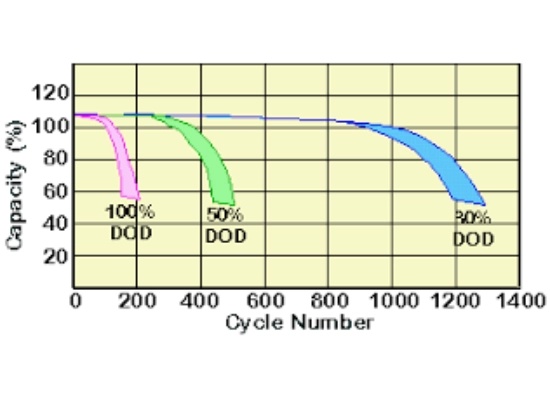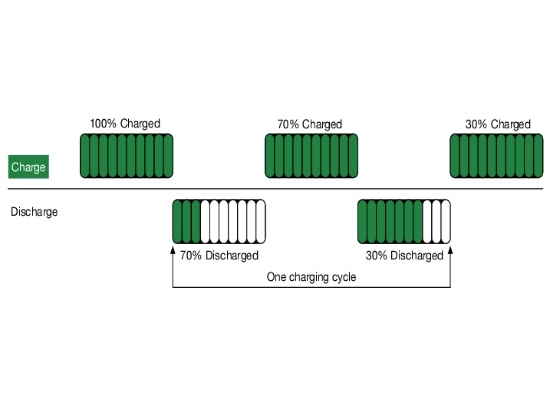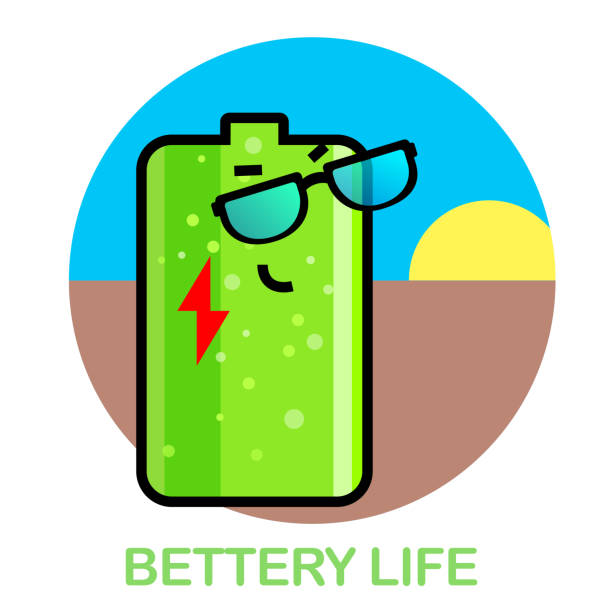Li 이온을 이해합니다 배터리 재충전 사이클 효과적인 관리 및 성능 향상에 중요합니다.
이 기사에서는 리튬 이온 충전 주기의 핵심 역할을 살펴보겠습니다., 깊은 충전과 얕은 충전의 차이점, 리튬 배터리 재활용의 타당성, 배터리 수명을 효과적으로 연장하는 방법.
그것이 당신에게 도움이 될 것이라고 생각하십시오.
배터리 사이클 카운팅이란 무엇입니까??

배터리의 사이클 수, 충전 주기 또는 방전 주기라고도 함, 배터리를 완전 방전된 상태에서 완전 충전된 상태로 충전하는 전체 주기를 말합니다., 그런 다음 빈 상태로 방전합니다..
이 프로세스는 배터리가 경험하는 완전한 충전 및 방전 주기를 나타냅니다., 배터리의 상태와 수명을 측정하는 중요한 매개변수입니다..
배터리 사이클 시간 추적은 배터리 수명과 밀접한 관련이 있으므로 중요합니다.. 각 충전 주기마다 배터리 용량이 약간 감소할 수 있습니다..
리튬이온 배터리를 예로 들면, 각 사이클 이후, 배터리 용량이 약간 줄어들 것입니다., 이는 점차적으로 장치의 사용 시간과 배터리 성능에 영향을 미칩니다..
배터리 사이클 계산은 배터리의 예상 수명을 예측하고 현재 상태를 평가하는 데 중요합니다..
EV 충전기 제조업체 사용자는 배터리를 교체해야 하거나 주기 계산을 기반으로 심각한 성능 저하가 발생하기 전에 배터리가 얼마나 오래 지속될 수 있는지 추정해야 합니다..
충전주기란 무엇인가요??

충전주기는 재충전 가능한 배터리가 겪는 완전한 충전 및 방전 과정을 나타냅니다..
배터리가 방전될 때까지 소형 기기를 사용하는 경우, 당신은 방전 중입니다.
배터리는 일반적으로 사용 또는 구매 전 생산 과정에서 사전 충전됩니다..
충전식 배터리의 충전 주기를 평가하는 표준 방법은 성능이 크게 저하되기 전에 배터리가 견딜 수 있는 총 충전 및 방전 주기 수를 계산하는 것입니다..
빈도, 전압, 배터리 수명 (밀리암페어시/mAh 단위로 측정됨) 충전 주기는 2차 전지의 성능을 측정하는 주요 지표입니다..
충전 주기는 배터리가 완전히 충전된 상태에서 완전히 방전된 상태까지의 전체 과정일 수 있습니다., 또는 배터리의 총 용량과 동일하게 누적되는 일련의 불연속 부분 방전.
리튬 배터리 심충전 및 얕은 충전이란 무엇입니까??

리튬 배터리의 충전 전략은 두 가지 방법으로 나눌 수 있습니다: 깊은 충전과 얕은 충전, 각각은 배터리 수명과 성능에 서로 다른 영향을 미칩니다..
깊은 충전 리튬 배터리를 최대 용량까지 충전하는 것을 말합니다., 이는 100% 요금.
이 충전 방법을 사용하면 배터리 전극이 최대한 많은 에너지를 흡수할 수 있습니다., 하지만 동시에, 또한 배터리에 상당한 압력을 가합니다..
특히 충전 한도에 가까워지면, 배터리 내부 화학 반응의 노화를 가속화할 수 있습니다., 그로 인해 서비스 수명이 단축됩니다..
상대적으로 말하면, 얕은 충전은 리튬 배터리를 최대 용량보다 낮은 수준으로 충전하는 것을 의미합니다., ~와 같은 20% 또는 50%.
이 방법은 배터리의 압력을 줄이고 충전 한계에 도달하는 것을 방지합니다..
하지만 오랫동안 완전히 충전되지 않은 경우, 배터리 보정이 실패할 수 있습니다., 배터리 잔량 표시의 정확성에 영향을 미침.
리튬 배터리는 얕은 방전 및 얕은 충전에 더 적합합니다., 장치의 전원 모듈에 배터리의 심부 충전 보정이 필요한 경우는 제외.
리튬 이온 구동 장치는 배터리 수명에 영향을 주지 않고 언제든지 충전할 수 있습니다..
얕은 사이클 충전은 짧은 에너지 버스트가 필요한 시나리오에 적합합니다., 딥사이클 충전은 배터리 잔량이 훨씬 낮아질 때까지 장기간 사용이 필요한 상황에 적합합니다. 50%.
리튬 배터리의 수명은 일반적으로 300 에게 500 충전주기, 배터리의 총 용량 Q와 매번 사용하는 전기량에 따라.
매번 용량의 절반을 사용하는 경우, 충전 시간은 도달할 수 있습니다 600-1000 타임스; 만약에 1/8 용량은 매번 사용됩니다, 충전 시간은 도달할 수 있습니다 2400-4000 타임스.
그러므로, 리튬 배터리의 수명은 총 충전량에 정비례합니다., 청구 횟수뿐만 아니라. 무작위로 충전하는 경우, 청구 횟수는 예측할 수 없습니다..
얕은 사이클 배터리의 수명을 연장하려면, 배터리 잔량이 약 2.5%로 떨어지면 자동으로 배터리를 차단하고 충전하는 방전 제어 회로를 설치하는 것이 좋습니다. 50%.
그리고 Deep 또는 Shallow Cycle 배터리의 건강 유지를 위해, 지능형 충전/방전 모니터는 필수 도구입니다..
배터리의 사이클이란 무엇입니까? ?
배터리 사이클링은 배터리를 완전 방전된 상태에서 완전 충전된 상태로 충전하는 전체 과정을 의미합니다.. 한번의 충전이 아니더라도, 배터리가 완전히 충전되어 있는 한, 한 사이클이 완료된 것으로 간주됩니다..
예를 들어, 하루에 배터리 용량의 절반만 사용하고 완전히 충전하는 경우, 이 프로세스는 완전한 충전 주기로도 간주됩니다..
리튬 배터리는 몇 번이나 순환할 수 있나요??
리튬이온 배터리의 예상 수명은 일반적으로 2 에게 3 년 또는 300 에게 500 완전한 충전 및 방전 주기, 어느 쪽이든 먼저 오는 것.
전체 충전 및 방전 주기가 완료되지 않은 배터리 팩의 경우, 우리는 일반적으로 평균 수명이 대략 다음과 같다고 생각합니다. 2 에게 3 연령.
하지만, 실제로는, 대부분의 리튬 배터리의 수명은 최소 기준을 훨씬 초과합니다., 도달하다 10 에게 15 연령.
저가형 납산 배터리의 수명은 일반적으로 5 에게 7 연령, 리튬이온 배터리의 수명은 약 3배 더 길지만.
리튬 배터리의 충전 수명은 제한되어 있으며 시간이 지남에 따라 전력을 유지하는 능력이 점차 상실됩니다., 이러한 용량 감소는 되돌릴 수 없습니다..
시간이 지남에 따라, 배터리 용량이 점차 줄어들 것입니다., 결과적으로 전원 공급 시간이 단축됩니다. (실행 시간).
사용하지 않거나 보관하지 않을 때에도, 리튬 이온 배터리 자연 방전이 일어나게 됩니다. 그러므로, 정기적으로 배터리 충전 상태를 확인하는 것이 매우 중요합니다..
대개, 기기의 사용설명서에는 배터리 상태 확인 및 충전 방법이 안내되어 있습니다..
리튬 배터리를 순환해야 합니까??
필요. 배터리 사이클링을 적당히 사용하면 수명을 연장하는 데 도움이 될 수 있습니다..
리튬 배터리가 완전히 충전된 상태에서 완전히 방전된 경우 25% 충전 상태 (SoC), 용량 손실이 가장 심함; 완전히 소진될 때까지 방전한 경우, 용량 손실은 더욱 커질 것입니다.
배터리 충전 중 100% 그런 다음 그것을 방전합니다. 50% 범위 내에서 사이클링하는 것에 비해 배터리 수명이 짧아집니다. 85% 에게 25%.
연구에 따르면 리튬 배터리를 충전하는 것으로 나타났습니다. 75% 그리고 그들을 방전 65% 용량 손실을 최소화할 수 있습니다..
리튬 배터리의 수명을 향상시키는 방법?

충전하기 전 장치의 사용 기간은 "배터리 수명"이라고합니다., 교체 전 배터리 사용 기간은 "배터리 수명"이라고합니다..
장치의 사용 습관은 배터리 수명과 내구성에 영향을 미칠 수 있습니다., 이는 배터리 재충전 주기와 직접적인 관련이 있습니다..
적절한 수준으로 충전: 배터리를 대략적으로 충전 80% 배터리의 부담을 줄이고 내구성을 향상시키는 데 도움이 됩니다..
적당한 배터리 저장 공간 유지: 리튬 배터리를 장기간 보관할 경우, 배터리 잔량을 대략적으로 유지하는 것이 좋습니다. 50% 배터리 압력을 줄이기 위해.
공식 충전기를 선택하세요: 안전하고 효율적인 충전 프로세스를 보장하려면 리튬 배터리 모델용으로 특별히 설계된 충전기를 사용하세요..
고속충전 사용 줄이기: 급속 충전 기능을 자주 사용하면 배터리 노화가 가속화되고 배터리 수명이 단축될 수 있으므로 피하세요..
펌웨어 업데이트: 정기적으로 장치 펌웨어를 업데이트하여 배터리 관리를 최적화하고 충전 효율성을 향상시킵니다..
배터리 부하 관리: 여러 리소스 집약적 애플리케이션을 동시에 실행하는 등 전력 소비가 높은 활동을 줄입니다..
자주 묻는 질문
리튬 이온 충전 주기란 무엇입니까??
리튬 배터리의 표준 충전 및 방전 주기는 배터리가 부족한 상태에서 최대 용량까지 완전히 충전될 때까지 충전하는 것을 의미합니다..
완전 방전 및 후속 충전 과정을 거친 후, 리튬 이온 배터리 충전 주기를 완료합니다..
리튬 이온 배터리를 오랫동안 충전기에 올려 놓을 수 있습니까??
리튬이온 배터리의 안전과 적절한 충전을 보장하기 위해, 끊임없는 전류/정전압 (참조/이력서) 충전이 일반적으로 사용됩니다..
이는 충전 과정에서, 배터리는 전압이 미리 설정된 값에 도달할 때까지 일정한 전류로 먼저 충전됩니다., 그러면 전류는 멈출 때까지 자동으로 감소합니다..
이 충전 메커니즘을 기반으로, 리튬 이온 배터리에 대해 적절한 전압 제한이 설정되어 있는 한, 배터리를 충전기에 오랫동안 올려두어도 문제가 없습니다..
충전기가 CC/CV 충전 곡선을 따르고 최대 전압과 전류가 안전한 범위 내에 유지되는 한, 배터리를 안전하게 충전할 수 있어요.
하지만, 완전히 충전된 상태를 오랫동안 유지하면 배터리 성능에 약간의 부정적인 영향을 미칠 수 있습니다..
리튬 이온 배터리 충전 주기는 몇 번입니까??
리튬 배터리의 충전 횟수는 사용 빈도에 따라 달라집니다., 충전 방법, 환경적 요인.
리튬 배터리의 충전 횟수는 사용 빈도에 따라 달라집니다., 충전 방법, 환경적 요인.
결론

리튬 이온 배터리는 최대 견딜 수 있습니다. 500 리튬 이온 배터리 수명 주기, 업계에서 흔히 있는 일이죠.
작업 원리에 대한 깊은 이해, 리튬 이온 충전 주기 규칙 익히기, 충전 메모리가 있는 리튬 배터리를 배양하면 이러한 배터리를 보다 효율적으로 사용할 수 있습니다..
완전 충전 주기, 전체 배터리 수명.
선택하다 GycxSlolar 당신에게 제공하기 위해 고품질 배터리 제품.
